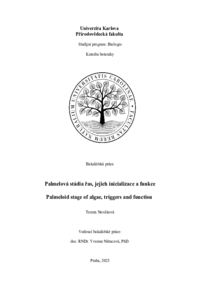Palmelová stádia řas, jejich inicializace a funkce
Palmeloid stage of algae, triggers and function
bakalářská práce (OBHÁJENO)

Zobrazit/
Trvalý odkaz
http://hdl.handle.net/20.500.11956/199326Identifikátory
SIS: 264068
Kolekce
- Kvalifikační práce [20861]
Autor
Vedoucí práce
Oponent práce
Pusztai, Martin
Fakulta / součást
Přírodovědecká fakulta
Obor
Biologie
Katedra / ústav / klinika
Katedra botaniky
Datum obhajoby
2. 6. 2025
Nakladatel
Univerzita Karlova, Přírodovědecká fakultaJazyk
Čeština
Známka
Výborně
Klíčová slova (česky)
oxidativní stres, extracelulární materiál, palmela, palmeloidní stádium, salinita, shluky buněk, spouštěče, vysychání, životní cyklus řasKlíčová slova (anglicky)
oxidative stress, extracellular material, palmella, palmeloid stage, salinity, cell clusters, triggers, desiccation, algal life cyclePalmeloidní stádium nebo fáze představuje dočasnou etapu životního cyklu některých bičíkatých řas. Během přeměny v palmelu dochází k ultrastrukturálním změnám jako je ztráta bičíků nebo zakulacení buňky. Následně buňky vytváří shluky obalené společnou slizovitou matrix. Zdá se, že ztráta motility a tvorba agregátů buněk obalených extracelulárním materiálem je obecnou odpovědí na změny podmínek prostředí, která se vyvinula nezávisle u zástupců fylogeneticky vzdálených linií fotosyntetizujících organismů tříd Chlorophyceae (Archaeplastida, Viridiplantae, Chlorophyta), Cryptophyceae (Cryptista), Euglenophyceae (Euglenozoa, Discoba), Chrysophyceae (Stramenopiles, SAR) a dalších. Cílem bakalářské práce je popsat a charakterizovat palmeloidní stádia u vybraných zástupců. U jednotlivých skupin objasnit ultrastrukturální změny buňky při transformaci v palmelu. Shrnout literaturu, která se zabývá podmínkami indukce palmeloidu (např. pomalé vysychání, zvýšená salinita, oxidativní stres, přítomnost predátorů, mikropolutanty a těžké kovy) a přiblížit podmínky, ve kterých dochází k reverzibilním návratu do vegetativního stádia bičíkovce. Následně nastínit funkce a význam tvorby palmelového stádia pro buňky dané skupiny. V závěru práce pak propojit a porovnat získané informace a následně se pokusit navrhnout...
The palmeloid stage or phase is a temporary stage in the life cycle of certain flagellate. During the transformation into palmella, various ultrastructural changes occur, such as the loss of the flagella and the rounding of the cell. Subsequently, the cells form clusters surrounded by a common mucilaginous matrix. The loss of motility and the formation of aggregates of cells coated with extracellular material appear to be a common adaptive response to changing environmental conditions that has evolved independently in phylogenetically distant lineages of photosynthetic organisms, including members of the classes Chlorophyceae (Archaeplastida, Viridiplantae, Chlorophyta), Cryptophyceae (Cryptista), Euglenophyceae (Euglenozoa, Discoba), Chrysophyceae (Stramenopiles, SAR) and others. The aim of the bachelor thesis is to describe and characterize the palmeloid stages of selected species. To elucidate the ultrastructural changes of the cell during the transformation into a palmeloid in each group. To summarize the literature dealing with the conditions of palmeloid induction (e.g. slow desiccation, increased salinity, oxidative stress, presence of predators, micropollutants and heavy metals) and to approximate the conditions under which a reversible return to the vegetative stage of the flagellate...
